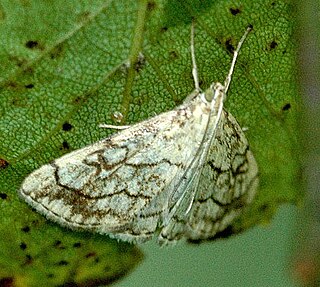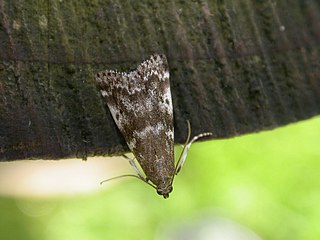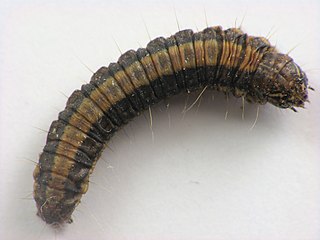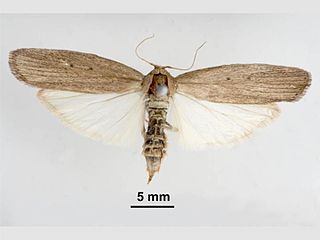
Crambidae comprises the grass moth family of lepidopterans. They are variable in appearance, with the nominal subfamily Crambinae taking up closely folded postures on grass stems where they are inconspicuous, while other subfamilies include brightly coloured and patterned insects that rest in wing-spread attitudes.

The Pyralidae, commonly called pyralid moths, snout moths or grass moths, are a family of Lepidoptera in the ditrysian superfamily Pyraloidea. In many classifications, the grass moths (Crambidae) are included in the Pyralidae as a subfamily, making the combined group one of the largest families in the Lepidoptera. The latest review by Eugene G. Munroe and Maria Alma Solis retain the Crambidae as a full family of Pyraloidea.

The Pyraloidea are a moth superfamily containing about 16,000 described species worldwide, and probably at least as many more remain to be described. They are generally fairly small moths, and as such, they have been traditionally associated with the paraphyletic Microlepidoptera.

The Mediterranean flour moth or mill moth is a moth of the family Pyralidae. It is a common pest of cereal grains, especially flour. This moth is found throughout the world, especially in countries with temperate climates. It prefers warm temperatures for more rapid development, but it can survive a wide range of temperatures.

Evergestinae is a fairly small subfamily of the lepidopteran family Crambidae, the crambid snout moths. The subfamily was described by H. Marion in 1952. It contains roughly 140 species on all continents and continental islands. Evergestine moths resemble Pyraustinae; however, the male genitalia have a long uncus and long, slender gnathos. The larvae feed mostly on Brassicaceae.
The Tineodidae or false plume moths are a family of moths with in some cases unusually modified wings: Like in some related moths, the wings of several Tineodidae are decomposed into several rigid spines. This is a small family, with about a global total of 20 species described to date; some undescribed species are known or suspected to exist however. They seem to be of Australian origin, where they are most diverse, but range through the Wallacea to Southeast and South Asia, and into the Pacific to the Marquesas Islands.

The Pyralinae are the typical subfamily of snout moths and occur essentially worldwide, in some cases aided by involuntary introduction by humans. They are rather rare in the Americas however, and their diversity in the Australian region is also limited. Altogether, this subfamily includes about 900 described species, but new ones continue to be discovered. Like many of their relatives in the superfamily Pyraloidea, the caterpillar larvae of many Pyralinae – and in some cases even the adults – have evolved the ability to use unusual foods for nutrition; a few of these can become harmful to humans as pests of stored goods.

Assara terebrella is a moth of the family Pyralidae. It is found in Europe, Korea, Japan (Hokkaido) and eastern Siberia.

Argyractis is a genus of moths of the family Crambidae.

Calamotropha is a genus of moths of the family Crambidae.

Palpita is a genus of moths of the family Crambidae. Members of the moth genus Stemorrhages may be very similar in appearance.

Merulempista cingillella is a moth of the family Pyralidae. It is known from China, Albania, Austria, Bosnia and Herzegovina, Croatia, France, Germany, Hungary, Italy, Russia, Slovakia, Spain, Switzerland, Turkey, Ukraine and Morocco.

The Phycitinae are a subfamily of snout moths. Even though the Pyralidae subfamilies are all quite diverse, Phycitinae stand out even by standards of their family: with over 600 genera considered valid and more than 4000 species placed here at present, they unite up more than three-quarters of living snout moth diversity. Together with the closely related Epipaschiinae, they are apparently the most advanced lineage of snout moths.

The Galleriinae are a subfamily of snout moths and occur essentially worldwide, in some cases aided by involuntary introduction by humans. This subfamily includes the wax moths, whose caterpillars (waxworms) are bred on a commercial scale as food for pets and as fishing bait; in the wild, these and other species of Galleriinae may also be harmful to humans as pests.

The Epipaschiinae are a subfamily of snout moths. More than 720 species are known today, which are found mainly in the tropics and subtropics. Some occur in temperate regions, but the subfamily is apparently completely absent from Europe, at least as native species. A few Epipaschiinae are crop pests that may occasionally become economically significant.

Eldana is a genus of moths of the family Pyralidae containing only one species, the African sugar-cane borer, which is commonly found in Equatorial Guinea, Ghana, Mozambique, Sierra Leone and South Africa. Adults have pale brown forewings with two small spots in the centre and light brown hindwings, and they have a wingspan of 35mm. This species is particularly relevant to humans because the larvae are a pest of the Saccharum species as well as several grain crops such as sorghum and maize. Other recorded host plants are cassava, rice and Cyperus species. When attacking these crops, E. saccharina bores into the stems of their host plant, causing severe damage to the crop. This behavior is the origin of the E. saccharrina's common name, the African sugar-cane borer. The African sugar-cane borer is a resilient pest, as it can survive crop burnings. Other methods such as intercropping and parasitic wasps have been employed to prevent further damage to crops.

Tirathaba rufivena, the coconut spike moth, greater coconut spike moth or oil palm bunch moth, is a moth of the family Pyralidae. It is found from south-east Asia to the Pacific islands, including Malaysia, the Cook Islands, the Philippines and the tropical region of Queensland, Australia. They are considered as a minor pest.

The Anerastiini are a tribe of moths of the family Pyralidae.
William Warren was an English entomologist who specialised in Lepidoptera.
Eugene Gordon Munroe was a Canadian entomologist who discovered numerous species of insects. He worked for the Insect Systematics and Biological Control Unit, Entomology Division in Ottawa, Ontario, Canada.













